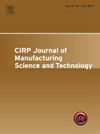Predictive modelling of surface roughness in precision grinding based on hybrid algorithm
IF 4.6
2区 工程技术
Q2 ENGINEERING, MANUFACTURING
CIRP Journal of Manufacturing Science and Technology
Pub Date : 2025-02-21
DOI:10.1016/j.cirpj.2025.02.004
引用次数: 0
Abstract
Aimed at predicting surface roughness (SR) of bearing outer rings under various grinding conditions, a model utilizing the DBO-1DCNN-LSTM algorithm was proposed. The structural parameters of the 1D convolutional neural network with long short-term memory neural networks (1DCNN-LSTM) combination model are optimized using Dung Beetle Optimization algorithm (DBO), and comparative experiments demonstrate the excellent performance in extracting features from multiple sources of signals during the grinding process. By utilizing the DBO-1DCNN-LSTM model to extract vibration and acoustic emission signal features in precision grinding of bearing outer rings, a predicting method for SR considering multi-source heterogeneous data is proposed. Signal characteristics with grinding parameters are combined to build a SR forecasting model of precision-ground outer rings under different operating conditions. Experimental results indicate that incorporating batch normalization layers and employing the grinding parameters as model input can effectively enhance the forecast accuracy. It achieves a coefficient of determination (R2) of 0.9910, average absolute error (MAE) of 0.0050, root mean square error (RMSE) of 0.0067, and mean absolute percentage error (MAPE) of 0.0491. Capable of accurately forecasting the SR of bearing outer rings across different grinding conditions by the proposed approach. The model can shorten the production cycle from machining to inspection, ensuring the qualification rate of workpieces directly during the machining process. This facilitates efficient quality control and timely comprehensive decision-making in bearing production, ultimately improving production efficiency.
求助全文
约1分钟内获得全文
求助全文
来源期刊

CIRP Journal of Manufacturing Science and Technology
Engineering-Industrial and Manufacturing Engineering
CiteScore
9.10
自引率
6.20%
发文量
166
审稿时长
63 days
期刊介绍:
The CIRP Journal of Manufacturing Science and Technology (CIRP-JMST) publishes fundamental papers on manufacturing processes, production equipment and automation, product design, manufacturing systems and production organisations up to the level of the production networks, including all the related technical, human and economic factors. Preference is given to contributions describing research results whose feasibility has been demonstrated either in a laboratory or in the industrial praxis. Case studies and review papers on specific issues in manufacturing science and technology are equally encouraged.
 求助内容:
求助内容: 应助结果提醒方式:
应助结果提醒方式:


